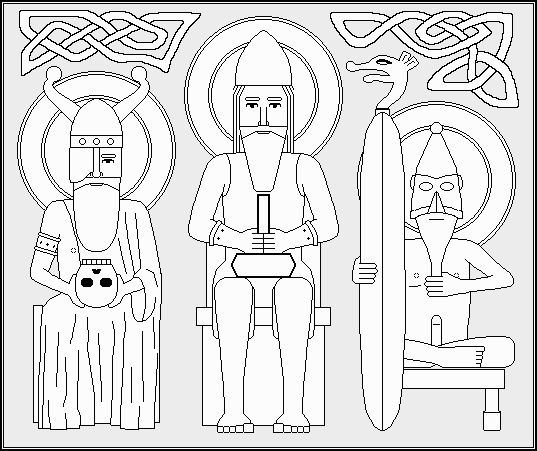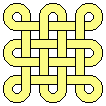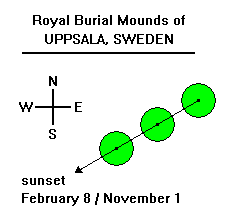
| |||||||||
| During the first millenium, the people of Europe were polytheistic. If we are talking about the Germanic Indo-Europeans, then their gods were the Aesir (sky gods) and the Vanir (earth gods). It is likely that the Germanic peoples believed that they originated by divine descent from the Aesir. Much of the religion and traditions of the "Dark Ages" became forgotten as a new cadre of indigenous Christian clergy emerged and castigated these people's heathen past. |

Three Gods were idolized in the famous temple of Gamla Uppsala, Sweden as shown in the artist's impression above. To the left is Odin, patriarch, lord of the Aesir and wisdom-god. He holds the divinatory head of Mimir. Center is Thor holding the hammer called Mjollnir. Being the largest statue indicates his primary importance. To the right is Freyr, a fertility god of the race of the Vanir. He holds the ship called Skidbladnir. The temple of Uppsala, a great wooden building with a golden roof, was destroyed early in the twelfth century, probably by King Ingold I.
|
|
By the accounts of Adam of Bremen, as well as other Christian missionaries, heathen ceremonies called the Disablots, dedicated to Odin, were practiced every eight years, even though Adam misunderstood this to be nine years. Here copius numbers of creatures were sacrificed and hung from ash trees in a sacred grove. Because these ceremonies always occured during the full moon, it is also correct to say that they very most often took place every 99th lunation. This cycle is known as the octaeteris. The moon of the ceremony was called the Disting or Disa Thing moon and occurred around February. The eight-year intervals are established -- examples of these "holy years" are; AD 700, 708, 716, ... etc..
|
|
A sacred grove of ash trees was the setting of this holiest of ceremonies. The ash tree is the kind exemplified by the world tree Yggdrassil. In creation, the first humans were made from the ash and the first man was even named Ask ( ash ). Odin hung from the ash tree without food or water, pierced by a spear, for nine nights and saw the vision of the runes and learned their meaning. Odin's self-sacrifice matches the description of features in the sacrifices of the heathen grove ceremony. Indeed, the Havamal ( Words of the High One ) provide some principle clues to the heathen religion and even the cult of Odin.
|
|
By historical accounts, the year has three festivals that are basic to the heathen orthodoxy. For example, they are mentioned by Snorri Sturluson in Ynglinga Saga. There is the post-harvest feast at winter's beginning ( the new year ). There are the mid-winter sacrifices. There are the summer solstice bonfires. We should note the correspondence between these holidays and the idols of Uppsala; Freyr, Odin, and Thor respectively. The mysteries of these holidays can be basically understood by considering the allegorical functions of these gods.
|
 |
 |
 |
|
Let us begin here to closely examine the science of time-keeping used long ago. The old calendar was luni-solar and is said to have begun the new year at the first new moon on or after October 14th. The calendar was necessary to account for the Disting or Disa Thing period: the fixed one-month period that contains the Disting moon. The thing was a sort of court, legislative assembly, or powwow. It is documented in Icelandic history that the determination of time and dates was part of the responsibility of the thing, and the Lawspeaker proclaimed the misseristal ( reckoning of the seasons/calendar ) for the coming year at the close of the assembly. This is one clue to the calendar's design; the thing period was likely seperated from October 14th by a whole number of lunar months. The historical accounts would then indicate that it preceded October 14th by 9 months. This period was then presumably January 21th - February 19th on the Julian calendar.
|
|
By the findings of this author, a reconstruction of the extinct calendar is possible that the evidence seems to substantiate. The reconstructed calendar predicts that the new year begins, according to the modern ( Gregorian ) calendar, with the first new moon that occurs on or after October 18th and this could be called ( new ) Winter's day.
This would translate to the traditional October 14th which is called (old) Winter's Day in the Julian calendar -- if we assume that the original calendar existed in the 8th or 9th century. This is in fact the time period of the beginning of the younger or Danish futhork, Metonic runic calendar-sticks, and the Havamal legend. Yet, as we will show, we need not rely on this observation to attest to the validity of the reconstructed model, rather we shall demonstrate the independent astromonical significance of October 18th.
|
|
The old calendar must have been designed to inform the user of the time of the year based on the sun and moon. In no way would he have needed to know about the Julian calendar or when October began to be able to announce the new year or attend the thing. Indeed the mysterious October 14th could only have arisen after the old calendar was compared to the Julian calendar. What we need to do is reconstruct a calendar from scratch, based on astronomical data, and then see if it matches the historical data in its antedated form. The success of this method will prove decisive.
|
|
Should we observe sunsets, much as the ancients did, we would note that the sun sets to the west. In the summer, the sun sets more to the north of west, and conversely, in the winter, the sun sets more to the south of west. In fact, except for the solstices, the sun crosses every point between the solstical setting points twice in a year and the time this takes differs from point to point on the horizon. For our purposes, we should note a point south of west that takes 9 lunar months for the sun to return to its setting point. Analytically we could say that if we watched the sunset on February 8th and the moon were full, then nine lunar months later, on November 1st, the sun would set at the same point and the moon would again be full. Both of these times correspond to a solar declination of about -14.7°.
|
|
Let us invent two month-long periods assigned to the dates: February 8th and November 1st, such that these dates mark the middle. February 8th would mark the middle of the month-long period: January 25th - February 23nd. In actuality, this month is known as Thorri and it is known that the mid-winter sacrifices took place during this month. Likewise, November 1st would mark the middle of the month-long period: October 18th - November 16th. This interval is not connected to an historic month name. Given these definitions, a calendar is essentially reconstructed that does what the old calendar supposedly did. The ( present ) thing period ( Thorri ) is January 25th - February 23nd. The ( present ) new year's new moon period is October 18th - November 16th. At this point we may realize that the scheme may be summarized very succinctly -- the new year begins on the 5th new moon after summer and the thing full moon is the 5th full moon before summer. By examining the antedated form of this model, finding its beginning with October 14th in the Julian calendar, we can date its usage to the 8th or 9th century, which is corroborated by the historical time of Odin's prominence in the heathen world.
|
|
The calendar is easier to understand by the use of the ancient runic calendar stick, also called clog almanacs, primestaves, or runestocks. We are now even equipt with the knowledge to calibrate a runic calendar stick to the ancient ( and now reconstructed ) heathen calendar. I shall now explain a runic calendar stick.
|
|
Runes are the letters of the ancient Germanic peoples. Futhorks are any alphabet of runes, so-named for the word spelled by the first 6 runes. The calendric futhork contains 19 runes. Each rune represents a number that is the year-number or golden number in a 19-year period called the enneadecaeteris or Metonic cycle in which 235 lunations almost exactly equal. Here is the calendric futhork below together with the golden number associated with each rune.
|

|
Yet when the full moons are plotted onto the calendar stick, the order is completely different. This is the chronologic order of the runes. The scrambled sequence below repeats over and over until 235 runes fill the time-line which represents one year. Each rune-interval equals about one day and 13.3 hours. Nine runes nearly equal a fortnight ( literally 14 nights ). The section below represents the beginning period October 18th - November 16th. These are runes 1 - 19 of the 235 rune series. The midpoint is rune 10 of the 235 rune series, which occurs nearest to November 1st which we know is a declination of the sun equal to -14.7°. It is because we know this declination that we could calibrate the calendar without any knowledge of the modern calendar. The runes represent full moons and the interstices represent new moons, 9 1/2 runes away from the full moon rune.
|

|
Next to show is the Thing period. The section below represents the period January 25th - February 23nd. These are runes 65 - 83 of the 235 rune series. The midpoint is rune 74 of the 235 rune series, which occurs nearest to February 8th which we again know is a declination of the sun equal to -14.7°. Note that from one rune to the next on the right is eight years ( 99 moons ), one reason that affirms that the Odinic rite occured octennially. Note that if it is the year-zero then a full moon falls on the center, then the next year-one ( a new Metonic cycle beginning with the earliest new moon ) is successfully predicted at the left-most interstice at the edge of the section above.
|

|
For every Metonic cycle, 7 out of 19 years will contain 13 months. These years are called "long years". These are the 7 years that begin earliest. Years that follow long years are the latest to begin. Now the thing moon is usually the 4th moon of the year, but sometimes it is the 3rd moon if the year is one of the latest to begin. Three out of 19 years will have the thing moon occuring as the third month. Evidently, if the year begins on November 12th or after, the thing moon will be the third. This is the point 12 months prior to October 18.
|
|
Calendar stick craftsmen would have recognized the spacing patterns of runes in comparison to days. If the runes were connected to days, then there would also be void days with no rune. The most apparent ratio of runes to days is 9:14, or nine runes per fortnight with 5 void days. So the fortnight might look like ( R = rune, x = void )
At 9 runes per fortnight, it takes 19 fortnights for the golden number pattern to repeat. So this returns us to the 266 day period that is also 9 months, and this is very strong corroboration to this calendar model. This also shows that the fortnight measure most likely began with runic chronology. |
|
King Aun's cycle is a period of 16 Metonic cycles, hence equals 304 years or 3760 lunations. It was known that 75 leap days were needed for this period to keep the runes stationary with a parallel day-wise calendar year of 365 days. The total number of days for this cycle was therefore 111035 days. Note that 111035 days / 3760 = 29 399 / 752 days is an extremely accurate approximation of the synodic month.
Yet when the runes were grafted to the Julian calendar, that added one leap day every 4 years, 304 years was reckoned to be 111036 days. Therefore the runes had to be shifted back by one day every 304 years. This was "King Aun's rule". |
|
| |

|
There is one more thing worth mentioning. Amid the premises of Uppsala are the three ‘royal’ burial mounds that have been dated to AD 450-550. One of these mounds is thought to be the resting place of the semi-legendary king Aun. As the old Scandinavians worshiped their ancestors, the mounds were also places of worship. Swedish archeaoastronomers have carefully studied the alignment of these mounds. Remarkably they are aligned such that they point to the February 8th - November 1st setting point on the horizon. Therefore, if the sun set at this point and the moon were full, the new year and a new metonic cycle would begin on the following October 18th according to the foregoing calendar model. |
|
From my hobby of sundials, I've collected most every formula related to the position of the sun and what information it reveals. Once I wondered where on Earth would the summer sun set in the north-west and the winter sun set in the south-west? Here also the summer sun would rise in the north-east and the winter sun would rise in the south-east. I derived the equation below. Recall that 23.439° is the tilt of the Earth.
|
|
This latitude ( conspicuously ) cuts through Moscow, Copenhagen, and Glasgow. It is quite certain to conclude that people from immemorial antiquity appreciated the aesthetics of this phenomenon. I call this latitude the golden latitude. It was latter I learned that Lejre, the great heathen center of Denmark and counterpart to Uppsala was located there.
|
|
Conclusion: I have reconstructed the extinct calendar of the heathen that astronomical and historical evidence seems to substantiate and without any need for the Roman calendars. The calendar explains the enigmatic old Winter's day and the once lost thing period. I have illustrated the religious purpose of the calendar.
I have introduced the Golden Latitude. This might explain why some major cities founded by Northmen exist where they do. The great heathen center: Lejre in Denmark is on this latitude. Today anyone can make a runic calendar stick and restart this ancient calendar by finding the years of the closest full moon to 2/8 or 11/1. Actually 2001 had a full moon on 11/1, so the golden number is 1. For the Odinic rite, the last holy year was 2004 and the interval will continue octennially. |

|
It seems the set of 19 runes in chronologic order deserve a distinctive name. I call it the "OTFI" so-named for the word spelled by the first 4 runes of the set shown above. The golden numbers associated with the otfi are thus 4-12-1-9-17-6-14-3-11-0-8-16-5-13-2-10-18-7-15. The otfi is a runic representation of a one month span on any calendar stick and 12 and 7 / 19 otfies equal one year.
|
|
The 17th, 18th, and 19th Runes | |

|
NAME: arlaug, aurlaugr NUMBER: 17 This rune is a ligature or bind-rune of ÁR and LOGR. The Hávamál refers to the seventeenth rune; "I know a seventeenth, and with that spell no maiden will forsake me." |

|
NAME: tvimadur, twimadur NUMBER: 18 This rune is a ligature or bind-rune of MADUR and YR. It is also called the Wendehorn rune. The Hávamál refers to the eighteenth rune as the best of the 18 charms; "What you alone know will wield influence." |

|
NAME: Belgthor, Belgtzbor, Bolthorn ( "evil giant" ) NUMBER: 0 or 19 This rune is a doubled version of the thorn ( third ) rune. It is also the single-staved mutation of the elder Dagaz (day) rune. The Hávamál refers to the thorn rune. "I know a third, if I should need to fetter any foe; it blunts the edge of my enemy's sword, neither wiles nor weapons work." The doubled rune aspect gives the offensive as well as the defensive power to the spell, therefore it will also sharpen one's own weapon and increase one's wiles. It is thoroughly a martial rune as well and an invocation of Bolthorn ( Odin's grandfather ), surely a revered war spirit. |